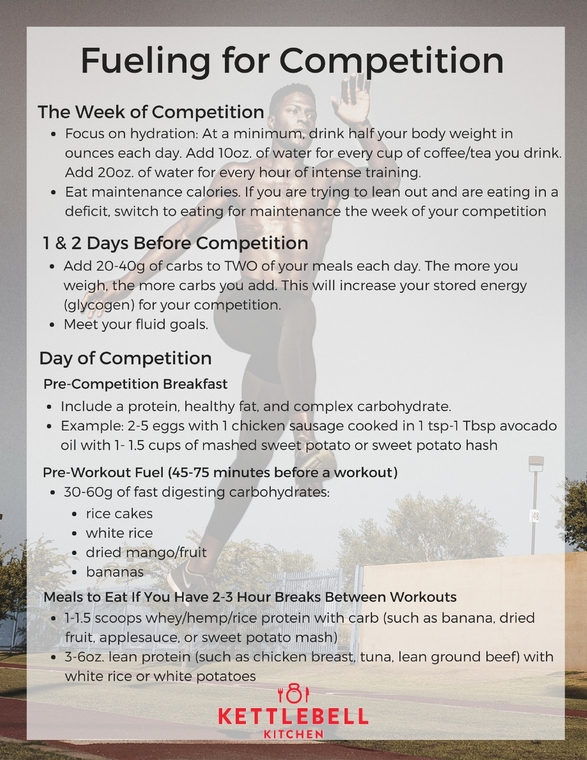Kettlebell Kitchen Sports Performance Nutrition Series: Part 2
May 12, 2017
Written by Kettlebell Kitchen Nutritionists: Amanda Montalvo, RD and Kim Jordan, NTP
In the last post we discussed inflammation and its effects on your gut, performance, and overall health. We highlighted foods to avoid and specific foods to include. So now that we’ve discussed the “what”, let’s go over the “how much.”
Kettlebell Kitchen Nutrition Hierarchy
The topics highlighted in the below pyramid are listed in order of importance and the overall affect on your body. Think of the bottom sections as foundations to build upon.

How Much Should You Be Eating?
You will notice that total energy from food (calories) is listed at the bottom of this pyramid. This is because it has a profound affect on your performance and overall health, especially weight and body composition. While the makeup of the foods you eat and where they come from matter immensely, you still must be eating an appropriate amount for your body and goals.
In order to calculate how many calories your body requires each day, you must start with your basal metabolic rate (BMR). BMR is an approximation of the bare minimum the body needs in order to function and not do anything at all. Our bodies actually require an astounding amount of energy to carry out all of the chemical reactions that occur on a daily basis. Below is the equation we use for meal plans at www.kettlebellkitchen.com to calculate your base calorie needs:
For Men : 10 x weight (kg) + 6.25 x height (cm) – 5 x Age + 5
For Women : 10 x weight (kg) + 6.25 x height (cm) – 5 x Age – 161
Once you know your BMR, you can then multiply by an activity factor based on your exercise schedule and daily activity (sitting, light active, very active moving around all day). This will calculate your TDEE (total daily energy expenditure), or the amount of calories you need to maintain your weight.
Micronutrients: Nutrient Density of Food and Why It Matters
The second topic of the pyramid is food quality and micronutrients. Micronutrients are nutrients we need in small amounts like vitamins and minerals. Nutrient density refers to the amount of micronutrients in a food vs. how many calories that food contains. For example, vegetables and fruits are extremely nutrient dense because they contain a large amount of vitamins, minerals, and fiber for very few calories when compared to other foods. These micronutrients are what allow our body to function properly, push hard during a workout, and recover well.
Macronutrient Ratios
You may have had a specific macronutrient (nutrients we need in larger amounts) ratio recommended to you before. Maybe you have even tracked your macros on your favorite app. Your macro (protein, carbs, and fat) needs are extremely individual. We prefer to base them off bodyweight and factor in activity and goals. Below outlines the best way we have found to determine your macros for performance athletes. We recommend using at least your TDEE as your calorie goal to best support performance.
Fueling for Competition
To ensure that you perform at your highest level, it’s important to properly fuel for competition. You will notice that we highlight the week and days leading up to The D10 in our guide below. Keep in mind that what you eat the days and even weeks leading up to competition is more important than what you eat the day of the competition.

That sums up how to know how much you should be eating, how to calculate your macros, and what to eat on competition day. In our last post of the series we will discuss nutrient timing and how to optimize this for performance and recovery. If you have any questions regarding the information in this post please don’t hesitate to reach out to nutrition@kettlebellkitchen.com. Need help with your nutrition? We offer sport performance meal plans at www.kettlebellkitchen.com. Use the code D10 for 10% off.